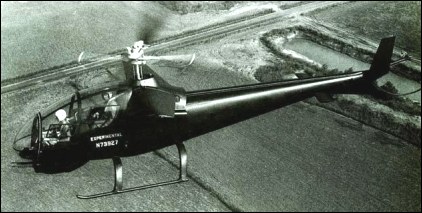
| Bell 207 Sioux Scout 1974 |  |
 |

| Bell 207 Sioux Scout 1974 |  |
 |
|
In July 1962, the experiments with armed helicopters turned to reality as the first Army armed helicopter company was activated in Okinawa for initial deployment in Vietnam. However, the evolution of armed helicopters led to such an increase in weight that the flight capabilities of these machines was severely compromised. Helicopter manufacturers began soon to develop new variants for an interim programme which later became known as AAFSS or Army's Advanced Aerial Fire Support System. Bell proposed the Warrior and, by December 1962, also modified an OH-13S as an armed helicopter which would combine the desired combat potential with the desired flight performance. The aircraft, known by Bell as Model 207 Sioux Scout embodied several elements which were to become commonplace on future armed attack helicopters, for instance, low drag profile, crew of two seated in tandem with integrated weapons, sighting systems and equipment. A new profiled fuselage was made from a Model 47J-2 rear fuselage mated with an all-new glazed streamlined cockpit with reinforced plastic bubble. The landing gear was of the classic skid-type. As powerplant the Sioux Scout retained the 260hp turbo-supercharged Lycoming TVO-435-A1A and had the rotor system of the OH-13S. The crew was seated in tandem with dual flying controls. The pilot was above and behind the gunner who controlled an Emerson Electric TAT-101 chin-turret armed with two 7.62mm machine-guns. This turret was a privately-funded modified version of the M-60-C gun barbette which, linked to the movement of the gunner's sight, could swivel 200deg in azimuth, and 15deg above and 45deg below the horizon. The Sioux Scout also incorporated stub wings which had been designed to carry auxiliary fuel tanks as well as providing extra lift. Flight tests showed that these wings also improved high-speed turning capability. Several types of wings were evaluated on the Model 207, as well as various types of cowlings, tailboom elevators and fins. The sole Model 207 prototype (N73927) made its maiden flight on 27 June, 1963, with Al Averill at the controls. This flight lasted ten minutes and by 25 July, the Sioux Scout had logged 18hr 30min flying. At the end of 1963, the aircraft was passed to the US Army for further evaluation by pilots of the IIth Air Assault Division at Fort Benning in Georgia. The Army pilots were surprised at the Model 207's capabilities and asked that such an aircraft but with a more powerful engine be promptly developed. In fact, albeit a highly promising concept, the Sioux Scout was somewhat limited in true combat capability and had no future. However, it was a major step forward to today's AAHs. A.J.Pelletier "Bell Aircraft since 1935", 1992
Predecessor of the AH-1 Cobra series, this experimental helicopter used the dynamics system and rear fuselage of a Bell OH-13 Sioux, married to a new gunship front fuselage. It had tandem seats with the operator of the twin turret (housing two 7.62mm weapons) behind the pilot. The one model built was evaluated by the US Army. G.Apostolo "The Illustrated Encyclopedia of Helicopters", 1984
|